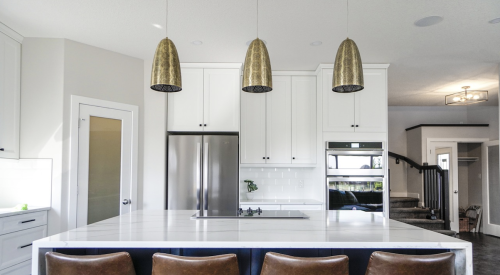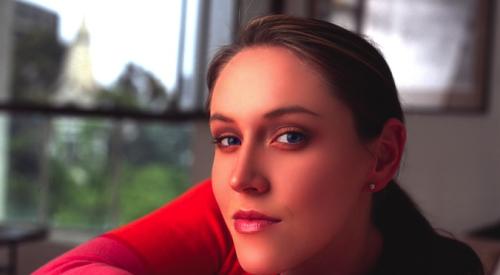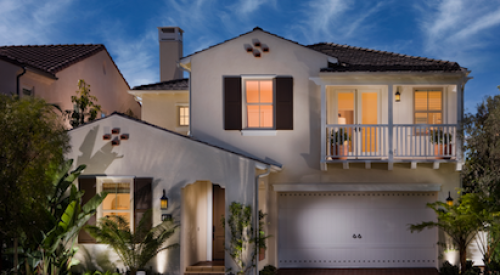|
She's in control of the purchasing decision whether she's single or married, has kids or doesn't, or is young or old. So why are you ignoring her?
A man and a woman walk into your model; they've got money to spend and are looking to buy. When you begin your sales presentation, who do you focus on? If you say the man, you'd be wrong.
"The home building industry, as well as anybody with a product to sell, must recognize how important it is to appeal to the woman buyer," says Doris Pearlman, MIRM, and president of Possibilities for Design. The Denver-based firm specializes in market-driven interior space merchandising and trend-setting design.
"[The woman] is the real driver behind the home buying decision. And her top concern remains how this purchase will enhance her lifestyle as well as that of her family."
Simply put, "If the wife doesn't immediately like the home, then the couple won't be buying it," says Jed Gibson, president of Toll Architecture in Horsham, Pa., a division of Toll Brothers responsible for new plan development for the national builder's northeastern region.
Under the InfluenceThe married woman remains a vocal and influential partner for her spouse when it comes to buying a home. However, as women have achieved economic independence through the years, the single female home buyer has emerged as a legitimate and profitable target market for builders to focus on. In fact, single women purchased one in five homes in 2003 as opposed to one in 10 purchased by single men, according to the National Association of Realtors.
And the makeup of the typical American household has changed dramatically as more women have made the choice to leave the role of full-time homemaker in favor of employment opportunities outside her home. In the past 40 years, for example, each successive generation has demonstrated a steady growth in female-centered, single-person households, non-family households and dual-income households. Married couples without children will account for nearly half of the projected growth in households over the next 10 years, according to the Nation's Housing report for 2006 compiled by Harvard University's Joint Center for Housing Studies.
"In the past, many builders turned a deaf ear to these emerging markets and continued to focus solely on designing homes for the traditional nuclear family. Interior designers found themselves having to disguise flaws in their homes because of this disconnect," says Georganne Derick, president of Merchandising East in Ellicott City, Md. Derick, who has won more than 90 regional design awards, is a frequent speaker, writer and trends expert.
"Women are more involved in the buying process than ever before, and that makes their role very significant," says Gloria Easler of Easler Construction located in Henry County, Ga. Easler, 2007 president of the Atlanta HBA's Metro South chapter, as well as a long-time Realtor, says new home merchandising should focus on convenience, flex space, time-saving features and casual living areas centered on the kitchen.
Architect Anne Olson, president of Olson Architecture in Niwot, Colo., is a nationally-recognized speaker on the subject of designing homes with women in mind and frequently serves as a judge for industry-related design competitions. "It makes the most sense to consider the woman when designing a home because she's already thinking of how to take care of everyone else," Olson says. "Meet her needs by improving the way the home functions — beginning with its design — and you've met the needs of everyone else living in there as well."
In a tight housing market, builders tend to adopt a marketing strategy that is totally cost-driven, Olson says. "When everyone else is selling basically the same thing, then all you have is cost to differentiate yourself from your competition. If, however, you make the effort to set yourself apart through better design, you will reach the woman buyer because she cares deeply about design."
And kitchens and master bathrooms continue to be the rooms that sell homes, agree the experts.
The KitchenThe kitchen is the ultimate home multi-tasking space, and it tops the list in rooms that are important to the female buyer. The well-designed kitchen assists her in handling everything from meal preparation and informal dining to supervising children's homework.
 |
Women are likely to opt for upgrades in the kitchen, says Kay Green, a nationally recognized leader in model home and sales center merchandising.
Key features that make a kitchen irresistible to many female buyers include:
- Multi-user design. The concept of the traditional work triangle, with its focus on optimizing the kitchen workspace and appliance location for the convenience of a single chef, has given way to new arrangements that promote socializing and make it practical for two or more cooks to work at the same time.
- Islands. Islands continue to be one of the most important and practical focal points in the kitchen. Not only do they contribute valuable work and storage space, but they also tend to be the spot where everyone gathers.
- Luxury finishes. Television shows, catalogs and even big box stores highlight the wide range of new products for homes available today. "And women want these things in their homes," says Pearlman.
- Customizable cabinetry. Special features including dedicated-purpose pull-out drawers, bins and built-in organization options are always highly desirable in kitchen cabinets.
- Professional-style appliances. According to our experts, women prefer the look of stainless steel appliances in their kitchens and choose larger refrigerators, ranges and separate cooktops whenever possible. They are also attracted to kitchen gadgets including refrigerated and warming drawers; wine coolers; and drawer-style dishwashers.
The female buyer looks to the master retreat to provide her with a sense of escape from stress of her busy lifestyle. For her, the crown jewel of the space is a luxurious bathroom that looks and functions as her own personal spa.
The oversized jet tub that has long been the focal point for the well-appointed master bathroom has been replaced by the spacious, luxury shower as the top choice for women when it comes to bathroom amenities. Vertical multi-head shower bars, ceiling-mounted rain showerheads and hand-held personal body sprays all make the shower more appealing. And built-in seating is a must.
Other hot features in the bathroom:
- Separate his and her vanities rather than a single counter with two basins
- Private toilet
- Chromatherapy lighting
- Aromatherapy showerheads
- Luxury footbaths
- Steam showers
- Practical storage solutions such as tower cabinets
- Spa features including towel warming bars and radiant heating in floor
The newest dedicated space in the home, the "command center" may be a completely separate room or simply a nook adjacent to but visually separated from the kitchen. The command center must include a planning desk and built-in organization features.
"It has become a very important space for both stay-at-home and working moms," says Olson. "With its close connection to the kitchen, the command center keeps women connected to the activity going on in the home rather than isolating them."
The Family FoyerIn today's woman-friendly floor plans, the mud room — that traditional catch-all space connecting the garage to the main living space of the home — has been redefined, reconfigured and appropriately renamed the family foyer.
Gone are the washer and dryer, and in their place, the space may have a small bench or desk and
 |
"The stuff that we carry around with us every day needs a place to go when we get home," says Gibson of this new and very popular stop-and-drop space.
The Laundry Room"The feedback that we get most often about the laundry room is that people prefer not to walk into their home through it," says Gibson.
A more sensible solution, agree the experts, is to locate the washer and dryer in its own separate room adjacent to the family foyer, or better still, to move the laundry facilities closer to where the laundry is actually being generated — near the bedrooms.
Opportunities for Organization"Clutter leads to stress for women," says Derick, "and they are always looking ways to help eliminate it from their homes. Serendipitous chunks of storage space will appeal to her."
These include:
- Bulk storage areas
- Walk-in pantries
- Multiple closets
- Built-in organizers
- Window seats, benches and niches
"Women are attracted to little alcoves and niches as opposed to large formal offices or dens," adds Green. "A big reason for this is their desire to stay connected to the rest of the household."
Other Key Features- Curb appeal. The exterior style and finish of her home is very important to the female buyer because it immediately expresses perceived value and the owner's personality, Easler says. Female buyers tend to be drawn to opportunities to express their individuality through their home.
- Ability to customize. Women appreciate being able to establish their own style in their home, and builders have a great opportunity to reach the female buyer on this level by giving them lots of choices, says Derick. For small or mid-size builders who don't maintain their own design center, she suggests allowing a woman to make her own selections at her local home center. The result, she says, is a home with a more custom look.
- Less volume. Rather than big soaring ceilings, women feel more comfortable with modest, 10- to 12-foot heights.
- Interior jewelry. "Finishes make a big difference to the woman buyer," says Olson. Interior drama can be achieved through the use of applied moldings, beamed ceilings, columns, unique doors,and beautiful plumbing fixtures, cabinetry hardware and custom lighting.
- Healthy alternatives. Women are very concerned about establishing a healthy living environment within their homes. Hard surface flooring including wood, tile, stone and laminate, for example, has become very popular with female buyers in all markets because it requires less maintenance and seems cleaner than conventional carpet.
- Flexible floor plans. Women readily see the sense in floor plans that offer flexibility in adapting to their own or their family's current needs as well as to their lifestyle requirements as they change.
- Practical technology. Women are not as technology-driven as men," says Pearlman. "If it is not easy to use and does not simplify their lives, they are more likely to do without it."
- Outdoor living space. Covered porches, three-season rooms, decks, terraces, lanais and grilling porches are very popular with women in all markets. Many homes today include several distinct outdoor areas, including one connected to the kitchen or great room and another off the master suite or den.
Catch the eye of today's female home buyer with unique and luxurious interior details, plenty of opportunity to customize her home inside and out, and a floor plan that simplifies her busy life and you'll be on the right road toward making the sale — even in a tough market.
|










